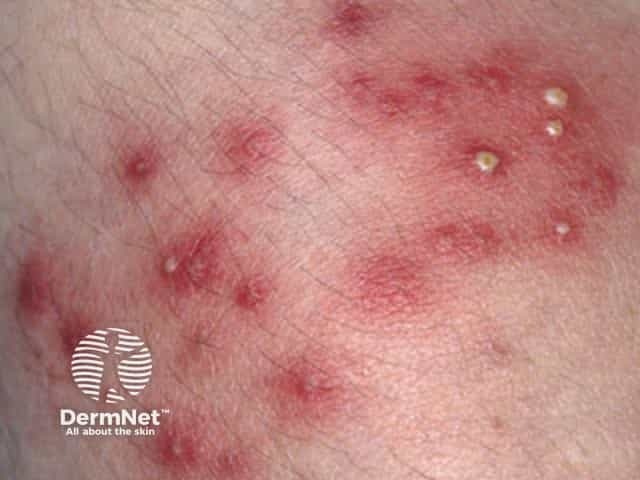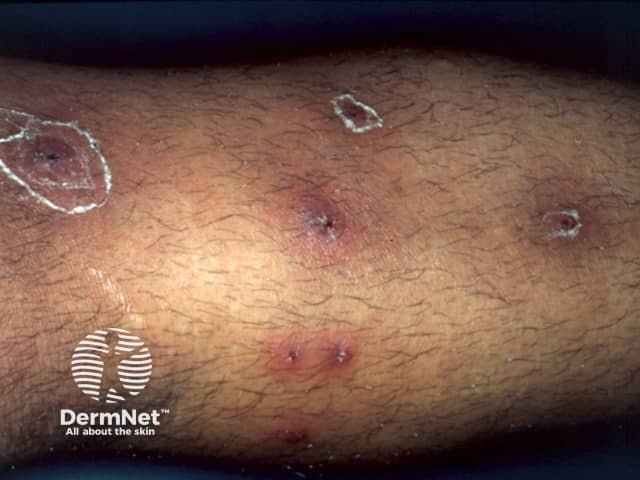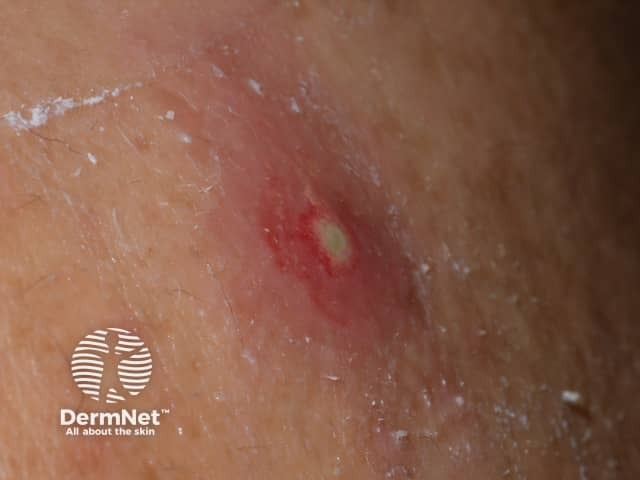Main menu
Common skin conditions

NEWS
Join DermNet PRO
Read more
Quick links
Bacterial folliculitis — extra information
Infections Follicular disorder
Bacterial folliculitis
Author: Hon. Assoc. Prof. Amanda Oakley, Dermatologist, Hamilton, New Zealand. September 2015. Reviewed and updated by Dr Jannet Gomez, Postgraduate student in Clinical Dermatology, Queen Mary University London, UK. January 2016.
Introduction
Causes
Demographics
Clinical features
Complications
Diagnosis
Prevention
Treatment
What is folliculitis?
Folliculitis is inflammation of the hair follicle due to infection, chemical irritation or physical injury. Bacterial folliculitis is the most common form of folliculitis.
What causes bacterial folliculitis?
Bacterial folliculitis is usually due to Staphylococcus aureus. Less often, coagulase-negative staphylococci and gram-negative organisms are responsible including anaerobes. Spa pool folliculitis is caused by Pseudomonas.
Who gets bacterial folliculitis?
Bacterial folliculitis affects children and adults, with adolescents and young adult males most often infected. It is prevalent worldwide.
The following factors predispose to bacterial folliculitis:
- Maceration and occlusion (clothing, dressings, ointments)
- Frequent shaving, waxing or other forms of depilation
- Friction from tight clothing
- Atopic dermatitis
- Acne or other follicular skin disorder
- Use of topical corticosteroids
- Previous long-term use of antibiotics
- Anaemia, obesity, diabetes, human immunodeficiency virus (HIV)/AIDS, viral hepatitis, cancer and other chronic illness
- Bathing in an inadequately cleansed hot tub or pool.
What are the clinical features of bacterial folliculitis?
Bacterial folliculitis may be superficial or involve the whole hair follicle (a boil). It may arise on any body site but is most often diagnosed in the scalp, beard area, axilla, buttocks and extremities. Systemic symptoms are uncommon. Different types of bacterial folliculitis are described below.
Superficial folliculitis
Superficial staphylococcal folliculitis presents with one or more follicular pustules. They may be itchy or mildly sore. Superficial folliculitis heals without scarring.
A hordeolum or stye is bacterial folliculitis affecting an eyelash.
Furunculosis/boils
Furunculosis or boils presents as one or more painful, hot, firm or fluctuant, red nodules or walled-off abscesses (collections of pus). A carbuncle is the name used when a focus of infection involves several follicles and has multiple draining sinuses. Recovery leaves a scar.
Gram-negative folliculitis
Gram-negative folliculitis develops in individuals using long term antibiotics for acne. The infection with Gram-negative organisms causes pustules in acne sites of the face, neck and upper trunk.
Hot tub folliculitis
Hot tub or spa pool folliculitis presents with painful papules and pustules on the trunk some hours after soaking in hot water, mainly in sites that were covered by bathing costume. It may be accompanied by mild systemic symptoms including fever. Untreated, it settles within about 10 days without scarring.

Superficial bacterial folliculitis

Superficial bacterial folliculitis


Complications of bacterial folliculitis
Soft tissue infection
Bacterial folliculitis can lead to cellulitis and lymphangitis; subsequent bacteraemia might result in osteomyelitis, septic arthritis or pneumonia.
How is bacterial folliculitis diagnosed?
Bacterial folliculitis is usually diagnosed clinically but can be confirmed by bacterial swabs sent for microscopy, culture and sensitivity.
Blood count may reveal neutrophil leucocytosis when folliculitis is widespread.
Skin biopsy is rarely necessary. Histology shows dense neutrophilic infiltrate in the subcutaneous tissue and foreign body reaction around a hair shaft.
How can folliculitis be prevented?
- Keep skin clean and if dry, well moisturised.
- Minimise shaving and waxing. When shaving, use a new blade each time and moisturise the skin afterwards.
- Do not wear tight-fitting clothes.
- Ensure adequate sterilisation of hot tubs.
- In case of repeated episodes of staphylococcal folliculitis, apply mupirocin ointment to the nostrils to eliminate S. aureus carrier state.
What is the treatment for bacterial folliculitis?
- Warm compresses to relieve itch and pain
- Analgesics and anti-inflammatories to relieve pain
- Antiseptic cleansers (eg, hydrogen peroxide, chlorhexidine, triclosan)
- Incision and drainage of fluctuant lesions and abscesses
- Topical antibiotics such as erythromycin, clindamycin, mupirocin and fusidic acid. To reduce bacterial resistance, these should be applied for courses of no more than one week
- Oral or intravenous antibiotics for more extensive or severe infections
- Photodynamic therapy
- Repeated laser hair removal
References
- Durdu M, Ilkit M. First step in the differential diagnosis of folliculitis: cytology. Crit Rev Microbiol. 2013 Feb;39(1):9-25. doi: 10.3109/1040841X.2012.682051. Epub 2012 May 29. Review. PubMed
- Folliculitis — Mayo Clinic Patient Care and Health Info
On DermNet
- Folliculitis
- Acne
- Furunculosis (boils)
- Scalp folliculitis
- Oil folliculitis
- Gram-negative folliculitis
- Spa pool folliculitis
- Folliculitis barbae
- Pseudofolliculitis barbae (razor bumps)
- Pityrosporum folliculitis
- Folliculitis decalvans
Other websites
- Bacterials infections of the skin — DermNet e-lecture [Youtube]
- Folliculitis — Medscape Reference
